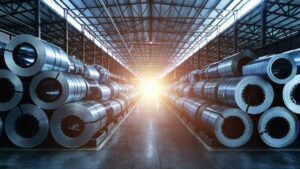How high can iron ore prices go?

Pic: Bloomberg Creative / Bloomberg Creative Photos via Getty Images
Iron ore is going gangbusters.
Hungry Chinese steel mills, which are producing more than 90 million tonnes a month, pushed iron ore prices to two-month highs on Friday.
Prices have now improved for six straight days to around $US130 per tonne. They’re up 10 per cent just in November.
Established supply from miners like Rio Tinto, BHP and Fortescue is struggling to meet this remarkable demand surge.
In 2009/2010 China spent huge amounts on infrastructure and construction to keep its economy growing through the Global Financial Crisis (GFC).
This had a direct impact on metals prices. Iron ore, nickel and copper are just a few that rebounded strongly in the ensuing period.
But analysts said this time would be different.
While China was ostensibly the first country to start recovery from virus-led economic shutdowns, an orderly recovery rather than a growth surge was more likely this time, said ANZ Research in March.
“At this stage, there are few signs the Chinese government will deliver a huge stimulus plan to boost the economy,” ANZ said.
“ANZ Research believes the government will adopt a targeted approach as they do not want to repeat the side-effects of the massive stimulus package in 2009, such as rapid debt growth and over-capacity issues.”
The analysts were incorrect.
Emerging from the COVID-19 pandemic, China has invested heavily into the domestic economy, pouring money into steel-hungry infrastructure.
“Steel production has gone up by 250 to 300 million tonnes. If you translate that into iron ore, China needs an extra about 400 to 500 million tonnes a year,” says Magnetite Mines (ASX:MGT) non-exec director Mark Eames.
“So far, their imports are only just picking up.
“They have hit about 1.3 billion tonnes [annualised] for two months — that’s huge number, but if you look at underlying steel production China is going to consume a lot more iron ore.
“That’s great news for Australia.”
Iron ore still has room to grow
Chinese steel mills are making good money, Eames says — a combination of the underlying strength of the economy and infrastructure spend.
“I think we may see steel production pull back a little, which is normal this time of year as we come into winter. That’s a seasonal effect,” he says.
“But at this stage there’s just no sign of things slowing down.
“Everyone is waiting month by month going ‘oh yeah, it will slow down’ but it has hasn’t happened.”
Right now, steel demand is a domestic China story, but Europe and the US are already talking about spending big on infrastructure once the pandemic subsides.
It’s inevitable that there is going to be a global economic rebound if the vaccines that people talk about prove to be successful, Eames says.
“That is going to translate into greater steel consumption across the world,” he says.
And the only producer that can really respond quickly at the moment is China.
We may see a synchronised recovery in 2021, with continued strength from China plus a rebound in the rest of the world, Eames says.
“I think we could see some very strong steel production numbers in the next 6 to 12 months if everyone can see a way out of this pandemic,” he says.
“It will be really interesting to see what happens in iron ore markets over the next six months.
“I think there’s all the conditions are in place for some real shortages in iron ore markets, and significant price responses.
“Watch this space, because it is going to get very interesting.”
Related Topics
UNLOCK INSIGHTS
Discover the untold stories of emerging ASX stocks.
Daily news and expert analysis, it's free to subscribe.
By proceeding, you confirm you understand that we handle personal information in accordance with our Privacy Policy.








